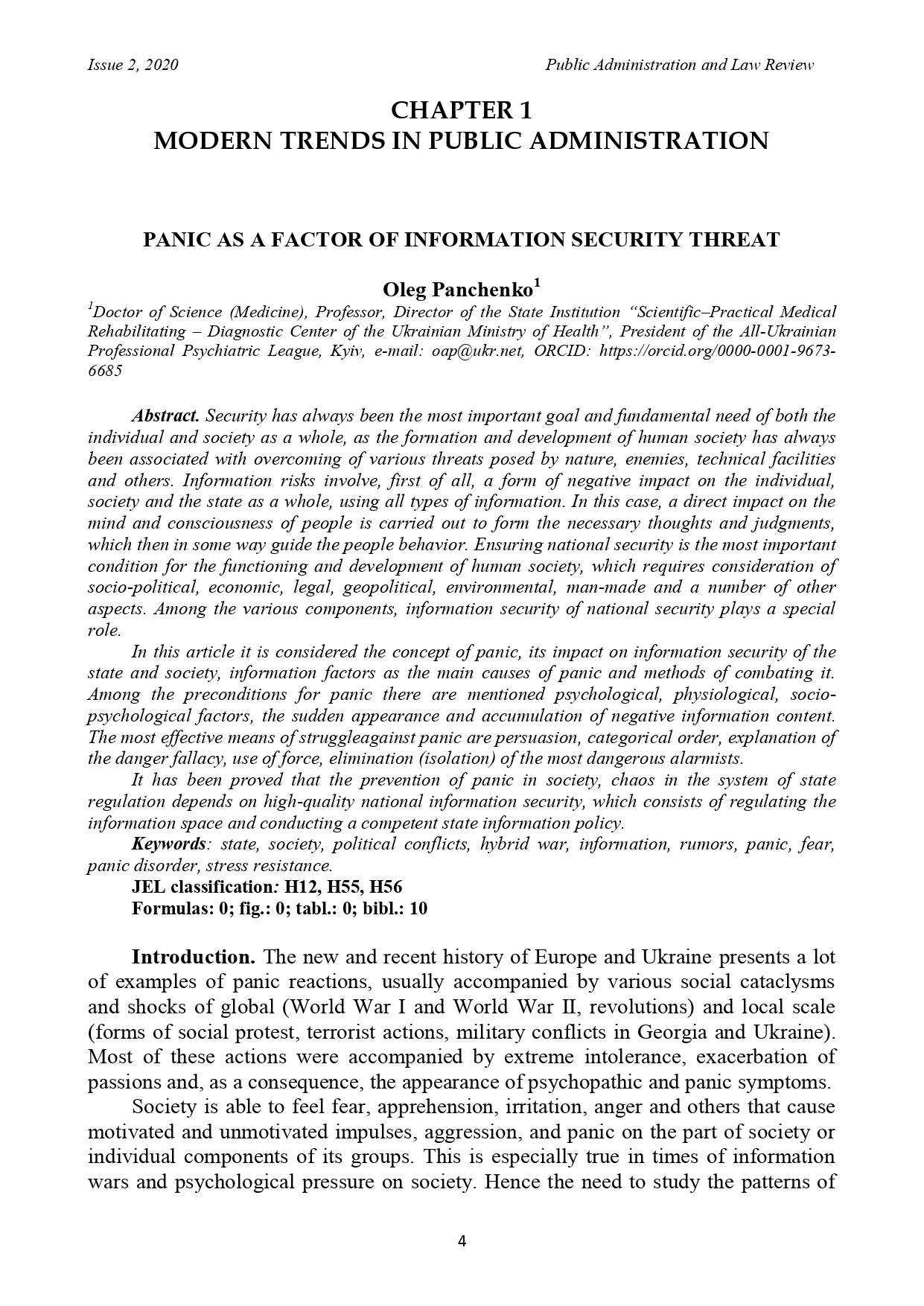PANIC AS A FACTOR OF INFORMATION SECURITY THREAT
DOI:
https://doi.org/10.36690/2674-5216-2020-2-4Keywords:
state, society, political conflicts, hybrid war, information, rumors, panic, fear, panic disorder, stress resistanceAbstract
Security has always been the most important goal and fundamental need of both the individual and society as a whole, as the formation and development of human society has always been associated with overcoming of various threats posed by nature, enemies, technical facilities and others. Information risks involve, first of all, a form of negative impact on the individual, society and the state as a whole, using all types of information. In this case, a direct impact on the mind and consciousness of people is carried out to form the necessary thoughts and judgments, which then in some way guide the people behavior. Ensuring national security is the most important condition for the functioning and development of human society, which requires consideration of socio-political, economic, legal, geopolitical, environmental, man-made and a number of other aspects. Among the various components, information security of national security plays a special role.
In this article it is considered the concept of panic, its impact on information security of the state and society, information factors as the main causes of panic and methods of combating it. Among the preconditions for panic there are mentioned psychological, physiological, socio-psychological factors, the sudden appearance and accumulation of negative information content. The most effective means of struggleagainst panic are persuasion, categorical order, explanation of the danger fallacy, use of force, elimination (isolation) of the most dangerous alarmists.
It has been proved that the prevention of panic in society, chaos in the system of state regulation depends on high-quality national information security, which consists of regulating the information space and conducting a competent state information policy.
Downloads
References
Andreyeva G. M. (2001), Sotsialnaya psikhologiya [Social Psychology], Tutorial, Press “Aspekt Press”, Moscow, 384 p. [Russia]
Gavrilets, I.G. (2006), Psikhofiziologiya cheloveka v ekstremalnykh situatsiyakh [Human psychophysiology in extreme situations], Tutorial, Press Vipol, Kiev, 188 p. [Ukraine]
Krysko V. G. (2006), Sotsialnaya psikhologiya [Social Psychology], Tutorial, Press Omega-l, Moscow, 352 p. [Russia]
Nazaretyan A.P. (2005), Psikhologiya stikhiynogo massovogo povedeniya: Tolpa, slukhi, politicheskiye i reklamnyye kampanii [Psychology of Elemental Mass Behavior: Crowd, Rumors, Political and Advertising Campaigns], Tutorial, Press Akademiya, Moscow, 160 p. [Russia]
Olshanskiy D. V. (2002), Psikhologiya mass [Psychology of the masses], Tutorial, Press Piter, St. Petersburg, 368 p. [Russia]
Androsyuk V. G. (2014), Psykholohiya ekstremalnoyi povedinky [Psychology of extreme behavior], Kiev, 393 p. [Ukraine]
Semikov V. L. (2006), Panika yak osoblyvyy vyd povedinky lyudey [Panic as a special kind of human behavior], Rezhym dostupu: http://www.narodttb/2009-6/02-06-09.ttb.pdf. [Ukraine]
Slyusar A. V Sotsialno-psykholohichni doslidzhennya panichnykh staniv [Social-psychological psychosocial station], Rezhym dostupu: URL: http://www.tpal.com.ua/spase/psyhsl/doc/info/4.pdf [Ukraine]
Jürgen Margraf (2013). Panik: Angstanfälle und Ihre Behandlung, Berlin, Press Springer Verlag, 260 p. [Germany]
Hans Morschitzky (2015). Endlich leben ohne Panik, Munderfing, Press Fischer & Gann Verlag, 278 p. [Austria]

Downloads
Published
How to Cite
Issue
Section
License
Copyright (c) 2020 Scientific Center of Innovative Researches OÜ

This work is licensed under a Creative Commons Attribution 4.0 International License.





